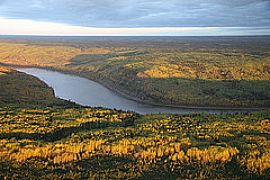
For years, First Nation communities and environmental groups have been drawing attention to the fact that tailings lakes are seeping toxic compounds into the region’s aquatic environment, including the Athabasca River and its tributaries. More than five years ago, the Pembina Institute was commissioned to compile tailings seepage rates based on data publicly available in oilsands mine applications. We were stunned to discover that, as of 2007, the total volume of tailings process-affected water likely seeping into the aquatic environment was 11 million litres per day.
Government and industry have challenged those concerns, contending that seepage is a “manageable issue” and that cumulative tailings seepage rates are "very low" due to monitoring systems and collection ditches built into tailings containment structures.
Last month, scientists from Environment Canada released a study citing research that estimated the rate at which tailings water is likely seeping from one lake (and into groundwater systems hydraulically connected to the Athabasca River). The research cited determined that rate to be 6.5 million litres per day. The authors use a scientific technique — known as chemical fingerprinting — to discern between groundwater that has interacted with natural bitumen deposits in the region and groundwater that has been contaminated by tailings.
In an interview with the Canadian Press, lead author Richard Frank said, “this is the strongest indication to date that process water is reaching the river system.” While the study doesn't represent definitive proof, as acknowledged by Environment Canada, it is highly suggestive and therefore merits attention.
It also provides further support for Pembina’s 2008 findings on the cumulative rate of tailings seepage in the oilsands, and aligns with research completed in 2010 by Total E&P Canada, which estimated that total seepage into the Athabasca River would be 12.6 million liters per day in 2013. Based on the academic sources cited in Environment Canada’s publication, we think seepage from oilsands tailings lakes could be materially higher than industry has projected.
Tailings: disappearing from the landscape?
Politicians and industry leaders often say that the problem of toxic tailings waste will soon be a thing of the past. Without question, many in industry and government take the problem very seriously and are working hard to eliminate it.
They point to the continued investment in tailings technologies, through collaborative efforts by the Canadian Oil Sands Innovation Alliance, as evidence of their efforts. They also cite Alberta’s tailings regulation, Directive 074, and its targets to reduce the volume of liquid tailings on the landscape, as an indication that this change will soon come.
We wish we shared that optimism. Despite major investments, technologies have not advanced at the rate that industry and government had originally hoped. Companies have had limited success with leading technologies and have been unable to meet the capture and trafficability requirements set out in Directive 074.
 Since the Directive was unveiled in 2009, the vast majority of companies have been unable to adhere to its rules. Data released by the Alberta Energy Regulator last summer showed that no companies met the tailings cleanup targets between July 2011 and June 2012. Moreover, the regulator chose to not enforce its own rules – it did not issue any penalties or even warnings for these failures.
Since the Directive was unveiled in 2009, the vast majority of companies have been unable to adhere to its rules. Data released by the Alberta Energy Regulator last summer showed that no companies met the tailings cleanup targets between July 2011 and June 2012. Moreover, the regulator chose to not enforce its own rules – it did not issue any penalties or even warnings for these failures.
The amount of tailings process-affected water seeping into the aquatic environment is clearly related to the tailings lakes in the region. Without enforcing Directive 074, there’s little hope that these lakes will disappear from the landscape. Unfortunately, the volume of tailings continues to grow in northeastern Alberta without penalty – and so too does the problem of tailings seepage.
Time for change
In early 2012, recognizing that Alberta’s environmental monitoring systems were inadequate, the governments of Alberta and Canada introduced the Joint Oil Sands Monitoring (JOSM) program. The program intends to increase (among other things) water monitoring activities in the oilsands region.
This was a much-needed first step in order to understand the impact of development on the regional aquatic ecosystems. However, increased monitoring is only useful if it informs management practices – and we have yet to see evidence that our governments are committed to using the information generated by JOSM to improve environmental performance in the oilsands.
While we welcome new publications on tailings science, such as the Frank et al. study for Environment Canada, we’re most interested in how governments will respond to this information. This tailings seepage study is expected to feed into upcoming research initiatives housed under JOSM – and we’ll be watching closely to see how proactive governments are in responding to the issue.
We expect that governments will take the evidence of tailings seepage seriously, and will provide a thoughtful policy response to this challenge. There has long been a fundamental disconnect between the environmental impact of oilsands expansion and the regulatory system governing the resource. Despite not having comprehensive data to assess the complete scope of environmental impacts, governments continue to approve new oilsands projects. It’s time for that to change.
Erin was the director of the Pembina Institute's federal policy program, specializing in climate policy and environmental assessments, until February 2018.



